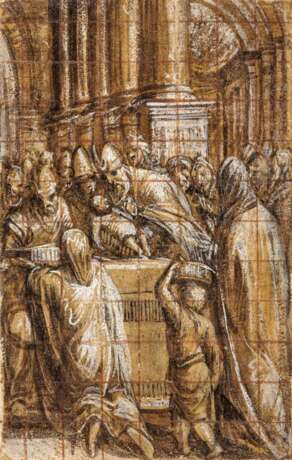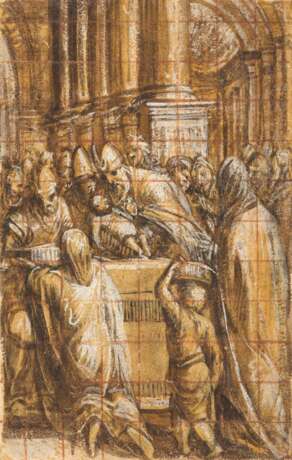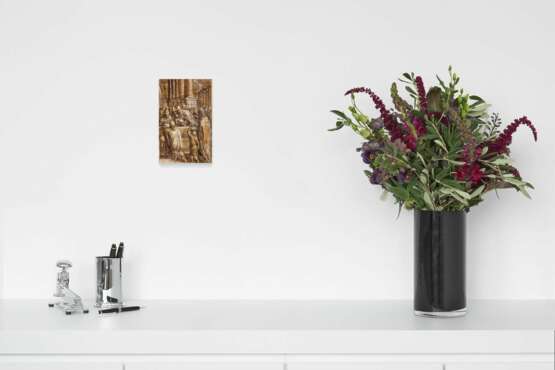ID 1207999
Lot 1004 | Hans Mielich. The Presentation of Christ in the Temple
Estimate value
€ 5 000 – 8 000
Title: The Presentation of Christ in the Temple.
Draft of one of man panels for the Inglostadt high alter.
Date: before 1572.
Technique: Black and brown chalk, heightened white, squared on beige paper.
Mounting: Mounted with self-adhesive tape at the top.
Measurement: 17 x 11cm.
Frame: Mat.
Provenance:
Private ownership, Germany.
We are grateful to Gode Krämer, Augsburg, who confirmed the attribution after examining the present drawing on the basis of a high-resolution photograph, for his help with the cataloguing.
Hans Mielich is considered one of the most important German artists of the late Renaissance. He achieved fame in his day for his paintings of sacred and historical subjects as well as for his portraits, which made him famous among the wealthy Munich bourgeoisie and at the court of Duke Albrecht V of Bavaria.
His relationship with the court was very close: from 1545/46, Albrecht V entrusted him with more and more commissions and he soon became a close friend. In particular, Mielich produced a graphic inventory of the ducal jewellery for the Duke of Bavaria: It comprises more than 100 drawings and is characterised by the accuracy of its depiction.
Drawing is an art in which the artist proved to be particularly skilful and which he used both as preparatory work for paintings and woodcuts and as an independent work of artistic and documentary value.
The high altar of Ingolstadt Minster 'Zur Schönen Unserer Lieben Frau' or 'Liebfrauenmünster' is one of the masterpieces from Mielich's last creative period and at the same time an important work of the southern German Counter-Reformation. Mielich and his workshop produced the more than 90 individual images of the altarpiece between 1560 and 1572.
The precious high altar, donated by Duke Albert V of Bavaria, was erected in 1572 to mark the first centenary of the church's construction. The altar is a reredos with double side wings, decorated with episodes from the life of the Virgin Mary. On the back is a depiction of St Catherine of Alexandria and the Magi.
Mielich made several drawings for this monumental work, a few of which have survived and bear witness to the artist's process from conception to design to realisation.
The present drawing is a preparatory work for a panel in the right wing of the upper outer register and shows the depiction of Christ in the temple. The artist has reproduced the structure of the drawing almost exactly and added a few smaller details in the background in the transition from drawing to painting, such as the candlesticks, candles and the two figures holding on to the pillar on the right.
In addition to this drawing, several others are known, such as the preparatory drawing for the Circumcision of Christ, the Marriage of the Virgin Mary to St Joseph (both in private collections) and the Nativity (Ottawa, National Gallery of Canada). All of these drawings, each measuring approximately 17.5 x 11.5 cm, are executed in the same technique and are similarly square, so that the artist explores the relationship between the various figures and ponders their transfer from a small sheet of paper to a large wooden board. The use of lead glazing is also appropriate as it allows the artist to better define the volumes in relation to the placement of the figures in space.
As few examples of Mielich's graphic work for altarpieces have survived, the present drawing represents a fundamental addition to the artist's graphic corpus, allowing us to better follow his ideational and operational practice from the drawing to the finished painting.
| Artist: | Hans Mielich (1516 - 1573) |
|---|---|
| Auction house category: | Watercolors and drawings |
| Artist: | Hans Mielich (1516 - 1573) |
|---|---|
| Auction house category: | Watercolors and drawings |
| Address of auction |
VAN HAM Kunstauktionen GmbH Hitzelerstr. 2 50968 Köln Germany | ||||||||||||||
|---|---|---|---|---|---|---|---|---|---|---|---|---|---|---|---|
| Preview | |||||||||||||||
| Phone | +49 221 92586215 | ||||||||||||||
| Fax | +49 221 92 58 62 4 | ||||||||||||||
| Buyer Premium | 32% | ||||||||||||||
| Conditions of purchase | Conditions of purchase | ||||||||||||||
| Business hours | Business hours
|






